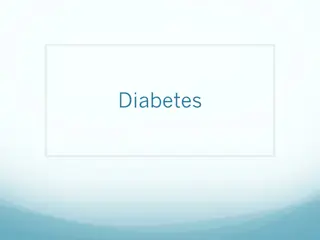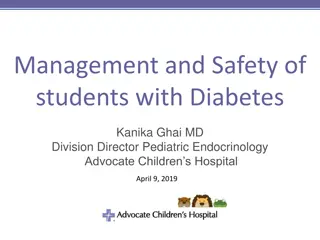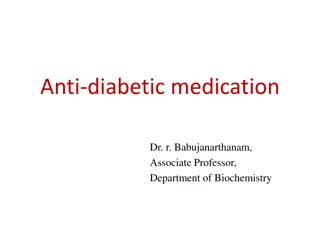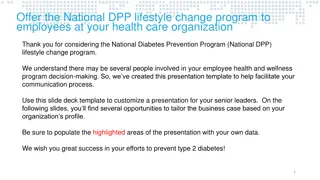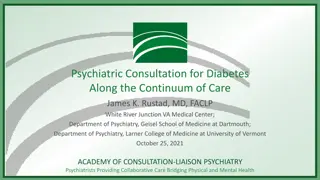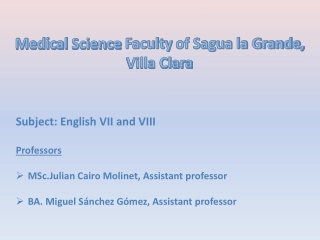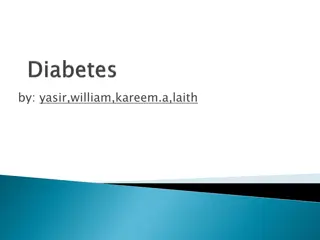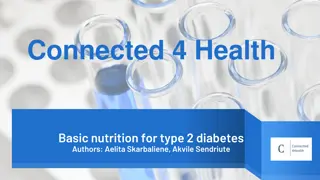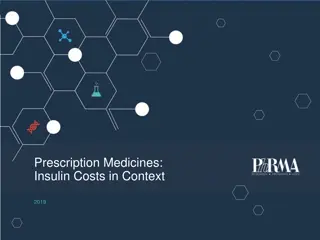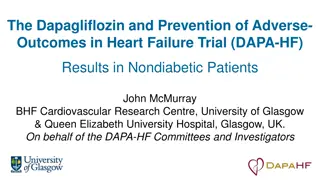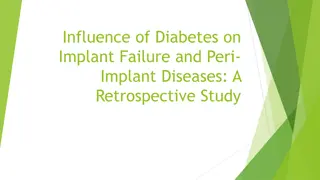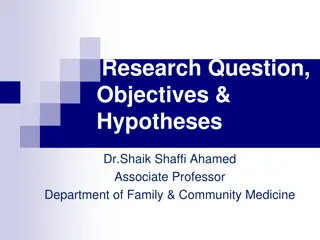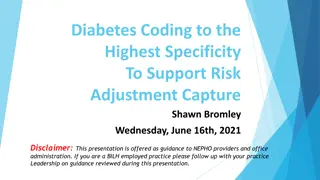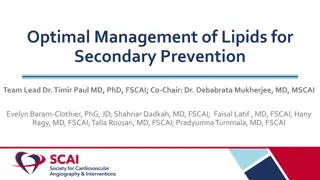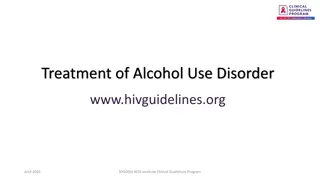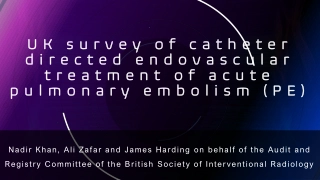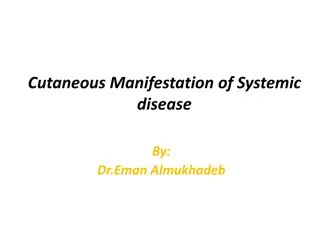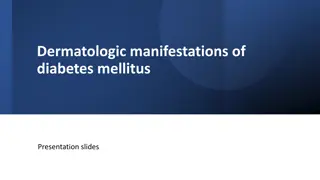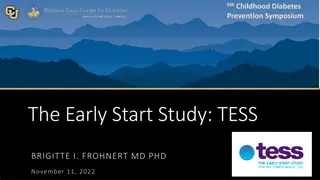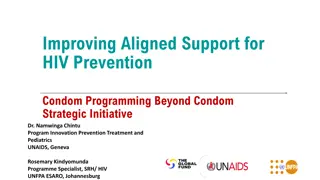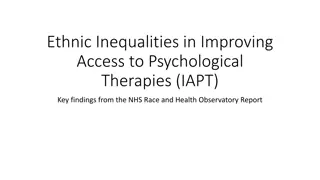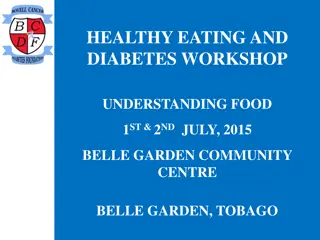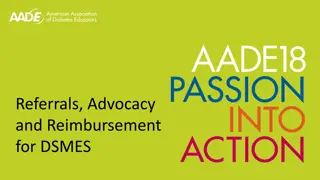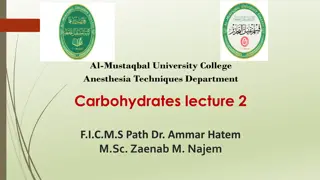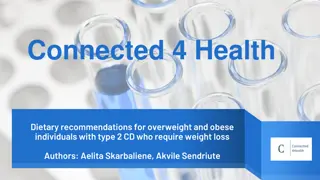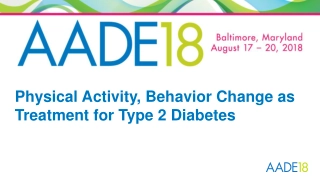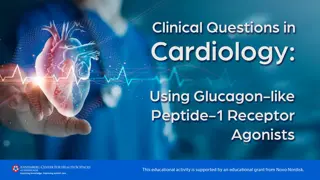New Therapies for Diabetes: A Focus on Prevention and Treatment
Explore the impact of diabetes worldwide and in South Africa, with a particular focus on the epidemiology, consequences, and current therapies for Type 2 diabetes. Dr. Poobalan Naidoo discusses the increasing prevalence of diabetes and the urgent need for new therapeutic approaches to combat this growing health concern.
Download Presentation

Please find below an Image/Link to download the presentation.
The content on the website is provided AS IS for your information and personal use only. It may not be sold, licensed, or shared on other websites without obtaining consent from the author. Download presentation by click this link. If you encounter any issues during the download, it is possible that the publisher has removed the file from their server.
E N D
Presentation Transcript
Diabetes: Focus on New therapies Dr Poobalan Naidoo BPharm MBBCh MMedSc (Pharmacology) FCP(SA) part 1 Medical Advisor Boehringer Ingelheim, South Africa 2014
Disclaimers Funding for IIS: Sandoz Consultant for Abbot Pharmaceuticals Medical advisor: Boehringer Ingelheim Senior Research Officer, UCT, Department of Medicine, Clinical Pharmacology 2
Outline of the presentation Type 2 Diabetes: epidemiology & consequences Current therapies New therapy: a mechanism for direct glucose removal New drug classes in Research and Development Take home message 3
Every 10 seconds... Two people develop diabetes The number of patients with diabetes worldwide is expected to increase from 366 million in 2011 to 552 million in 2030 Number of patients, millions 2011 2030 China North America and Caribbean South and Central America Europe Africa India Others 138 130 101 90 84 64 61 53 51 40 38 28 25 15 International Diabetes Federation. IDF Homepage. International Diabetes Federation 2011. Available from: http://www.idf.org/. 5
Diabetes in South Africa In South Africa, the prevalence is 9.2% in 20-79 year age group, accounting for approximately 2.6 million cases (IDF, 2013). Projection for 2035 is 3.94 million Currently, the number of annual diabetes related deaths in SA: 83 000 1. International Diabetes Federation. Diabetes Atlas, Fifth Edition: www.diabetesatlas.org. Accessed end 2013. 7
Every 10 seconds, one person dies from diabetes-related complications1 Diabetes significantly increases the risk of Stroke Heart disease by 2 4 fold2 by more than 2 4 fold2 In the next 24 hours, 17,280 patients will develop diabetes in USA 62 new patients will have severe vision loss due to diabetes2 137 new patients will need dialysis2 186 new patients will have an amputation2 1. International Diabetes Federation. Diabetes Atlas, Fifth Edition: www.diabetesatlas.org. Accessed 25 June 2012. Estimated based on mortality data; 2. Adapted from: CDC 2011 National Diabetes Fact Sheet: http://www.cdc.gov/diabetes/pubs/estimates11.htm#12. Accessed June 2011. 8
The majority of patients in USA with T2D remain far above glycaemic goals 10.1% have HbA1c >10%2 10.0 20.2% have HbA1c >9%1 9.0 37.2% have HbA1c >8%1 8.0 47.8% of patients with T2D have HbA1c >7.0%1* 7.0 ADA/EASD target (<7%)3,4 6.0 HbA1c *Adapted from Saydah SH, et al. JAMA. 2004;291:335 342. 1. Dodd AH, et al. Curr Med Res Opin.2000;291:1605 1613; 2. Oluwatowoju I, et al. Diabet Med. 2010;27:354 359; 3. ADA. Diabetes Care. 2013;36:S11 S66; 4. Inzucchi SE, et al. Diabetes Care. 2012;35:1364 1379; 9
Class Example Mechanism of action HbA1C Limitations Biguanides Metformin (-) hepatic glucose production (-) insulin resistance 1-1.5% GIT disturbances Weight gain Hypoglycaemia Limited durability Cardiovascular profile contentious SUs Gliclazide, glibenclamide, glipizide, glimiperide (+) insulin secretion 1-1.5% Fluid retention Weight gain Heart failure Thiazolidinediones (TZDs) Pioglitazone, rosiglitazone (-) insulin resistance 1-1.5% Limited HbA1c reduction DPP-4 inhibitors Sitagliptin, saxagliptin, linagliptin, alogliptin, vildagliptin (+) incretin levels (+) insulin (-) glucagon 0.7-0.8% Nausea Injection Cost GLP-1 receptor agonists Exendatide, liraglutide, albiglutide, dulaglutide (+) insulin (-) glucagon (-) gastric emptying (+) satiety 1-1.5%
Less commonly used/not all registered is SA Class Example Mechanism of action HbA1C Limitations Meglitinides Repaglinide Nateglinide (+) insulin secretion 1-1.5% Hypoglycaemia GIT disturbances Alpha-glucosidase inhibitors Acarbose, miglitol, voglibose (-) carbohydrate absorption 1-1.5% Injection Costly Amylinomimetics Pramlintide (-) glucagon (-) gastric emptying (-) appetite 1-1.5% Syncope Nausea Dopamine agonists Bromocriptine (+) insulin sensitivity 0.7-0.8% GIT disturbances Bile acid sequestrants Colesevelam (-) hepatic glucose production 1-1.5%
Current therapy has limitations Remains unmet needs and requirement for new therapies 13
Glucose homeostasis: its more than just -cell function
T2D is a dysregulation of glucose homeostasis characterized by persistent hyperglycaemia, impaired -cell function and insulin resistance Impaired -cell function Type 2 Diabetes Persistent hyperglycaemia Insulin resistance DeFronzo RA. Diabetes. 2009;58:773 795; Poitout V, Robertson RP. Endocrinology. 2002;143:339 342; Robertson RP, et al. Diabetes. 2003;52:581 587. 15
From the triumvirate to the ominous octet Decreased insulin secretion Decreased incretin effect Increased lipolysis Islet -cell Increased glucose re-absorption Hyperglycaemia Increased glucagon secretion Decreased glucose uptake Increased hepatic glucose production Neurotransmitter dysfunction DeFronzo RA. Diabetes. 2009;58:773 795. 16
Transport of glucose against a concentration gradient1,2 Segment S1 2 Basolateral membrane GLUT2 SGLT2 Glucose Glucose Na+ Glucose Na+ K+ Na+ K+ Na+/K+ATPase pump Lateral intercellular space Glucose 1. Wright EM, et al. Physiology. 2004;19:370 376. 2. Bakris GI, et al. Kidney Int. 2009;75:1272 1277. 19
Renal glucose re-absorption in healthy individuals Filtered glucose load 180 g/day SGLT2 ~ 90% SGLT1 ~ 10% Gerich JE. Diabet Med. 2010;27:136 142. 20
Renal glucose re-absorption in patients with hyperglycaemia Filtered glucose load > 180 g/day SGLT2 When blood glucose increases above the renal threshold (~ 10 mmol/l or 180 mg/dL), the capacity of the transporters is exceeded, resulting in urinary glucose excretion ~ 90% SGLT1 ~ 10% Gerich JE. Diabet Med. 2010;27:136 142. 21
SGLT2 inhibition: a mechanism for direct glucose removal
Urinary glucose excretion via SGLT2 inhibition Filtered glucose load > 180 g/day SGLT2 inhibitors reduce glucose re-absorption in the proximal tubule, leading to urinary glucose excretion* and osmotic diuresis SGLT2 SGLT2 inhibitor SGLT1 *Loss of ~ 80 g of glucose/day (~ 240 cal/day). Gerich JE. Diabet Med. 2010;27:136 142. 23
SGLT inhibitors Phlorizin (1933): extracted from bark of apple trees glucose ring connected to 2 phenol rings via oxygen inhibits both SGLT1 and SGLT2 More recent SGLT2 inhibitors: Sergliflozin Remogliflozin Development stopped Dapagliflozin Canagliflozin Empagliflozin Registered in EU and US Abdul-Ghani M et al Curr Diab Rep 2012; 12: 230-238
SGLT2 inhibition lowers glycaemia independently of -cell function and insulin resistance1 4 SGLT2 inhibition directly targets glucose via urinary glucose excretion Impaired -cell function Persistent Persistent hyperglycaemia hyperglycaemia Insulin resistance 1. DeFronzo RA. Diabetes. 2009;58:773 795. 2. Poitout V, Robertson RP. Endocrinology. 2002;143:339 342. 3. Robertson RP, et al. Diabetes. 2003;52:581 587. 4. DeFronzo RA. Diabetes Obes Metab. 2012;14:5 14. 27
Summary SGLT2 is responsible for ~ 90% of the total renal glucose re-absorption SGLT2 inhibition induces urinary glucose excretion, resulting in a reduction of blood glucose 28
Competitor analysis Characteristics of SGLT2 inhibitors in advanced development or launched Empagliflozin1 2014(EU/US) C-glycoside Dual renal and hepatic 50:50 Oral Once daily 10 mg and 25 mg Dapagliflozin2 2012 (EU) 2014 (US) C-glycoside Mainly hepatic 97:3 Oral Once daily 5 mg and 10 mg Canagliflozin3 2013 (EU/US) C-glycoside Mainly hepatic, no details reported Oral Once daily 100 mg and 300 mg Launch year Molecular class Metabolism MoA Dosing Administration Regimen Doses 1. Data on file; 2. Dapagliflozin SMPC; 3. Canagliflozin SMPC. 30
Competitor analysis PK/PD characteristics of empagliflozin, dapagliflozin and canagliflozin (1/2) Empagliflozin1 10 25 mg Dapagliflozin2-4 5 10 mg Canagliflozin5-7 100 300 mg PD Clinical doses in Phase III Selectivity over SGLT1 Glucose excretion >1:2500 1:1200 1:414 70 90 g/day 18 62 g/day ~70 g/day Duration of action T : 10 19h T : 17h T : 12 15 h PK Absorption Rapid; peak levels 1.5 h after dosing Rapid; peak levels 1.5 h after dosing Peak levels 2.75 h (300 mg) to 4 h (100 mg) after dosing Distribution Moderate volume of distribution; GI tract, urine and bile Not measurable in the central nervous system Modest extravascular distribution with a volume ranging from total body water in the dog and monkey to ~2-fold total body water in the rat Extensive tissue distribution, extensively bound to proteins in plasma (99%) 1. Thomas L, et al. Diabetes Obes Metab. 2012;14:94 96; 2. Komoroski B, et al. Clin Pharmacol Ther. 2009;85:520 526; 3. Komoroski B, et al. Clin Pharmacol Ther. 2009;85:513 519; 4. Obermeier MT, et al. Drug Metab Dis. 2010;38:405 414; 5. Schwartz SS, et al. Diabetes. 2010;59 (Suppl 1)(Abstract 564-P); 6. Sha S, et al. Diabetes Obes Metab. 2011;13:669 672; 7. Nomura S, et al. J Med Chem. 2010;53:6355 6360. 31
Class Benefits vs Risks Benefits Risks/Limitations Oral Once daily administration MOA independent of beta cell function and insulin resistance eGFR > 45-60 ml/min UTIs/GTIs New class with limited real world data Beyond HbA1c Weight reduction Blood pressure reduction (await CVOT data) 32
Pharmacotherapy for diabetes in 2025? Inhibitors of 11 -hydroxysteroid dehydrogenase 1, which reduce the glucocorticoid effects in liver and fat Insulin-releasing glucokinase activators and pancreatic-G-protein-coupled fatty-acid- receptor agonists Glucagon-receptor antagonists Metabolic inhibitors of hepatic glucose output are being assessed 33
Take home messages Type 2 Diabetes is increasing Currently glycaemic control is sub-optimal SGLT-2 inhibitors are the most recent addition to the armamentarium of anti- diabetic agents Research and Development Continuing more drugs coming
Acknowledgements Boehringer Ingelheim Prof Inzucchi Prof M Omar Dr K Ho Dr N Rohitlall Dr M Redelinghuys Dr N Mangeya D Thomson S Thomas R Black 35


